![]()
![]()
![]()
Use LEFT and RIGHT arrow keys to navigate between flashcards;
Use UP and DOWN arrow keys to flip the card;
H to show hint;
A reads text to speech;
75 Cards in this Set
- Front
- Back
|
What two components make up the vertebral joint? |
the vertebrae and the Intervertebral disc
|
|
|
What type of cartilage is present on the articulating surface of the body of a vertebrae? |
hylaine cartilage |
|
|
What facets does the articulation on one vertebrae with another involve in the facet joint/Zygapophysial? |
the inferior articulate facet of the vertebrae above with the superior articulate facet of the vertebrae below |
|
|
What type of joint is the facet joint? |
synovial joint |
|
|
What are the two parts of the intervertebral disc? |
nucleus pulposus: gelatinous mass, remnant of notochord and resists compression annulus fibrosus (around outside): resists rotation and made of fibrocartilage |
|
|
what joins the vertebrae together beside the facet joint? |
the intervertebral discs |
|
|
Where is the atlanto-occipital joint? |
between the occipital bone and the atlas |
|
|
what are the two deep ligaments of the atlanto-occipital joint? |
Apical ligament (odontoid to occipital bone) Alar ligament (odontoid process to occipital condyle) |
|
|
What are the superficial ligaments of the atlanto-occipital joint? |
the cruciform ligament (+ like shape) vertical fibres (occipital bone to C2) horizontal fibres (form the transverse ligament of the atlas) |
|
|
What is the function of the anterior longitudinal ligament? |
connects vertebral bodies and IV discs, sacrum to C1 vertebra and occipital bone stabalises and limits extension strong |
|
|
Where is the posterior longitudinal ligament located? |
behind the IV disc |
|
|
what is the function of the posterior longitudinal ligament? |
connects IV discs and vertebral bodies, sacrum to C2 prevents hyperflexion and disc herniation weak |
|
|
Where is the ligamentum flavum located? |
between the vertebrae connecting the laminae together |
|
|
what is the function of the ligamentum flavum? |
elastic, resist extension and maintain curvature |
|
|
Where is the supraspinous ligament located in the vertebrae? |
extends from the spinous process (most posterior) and supports the upright head |
|
|
Where is the interspinous ligament located in the vertebrae? |
connects the spinous process of adjacent vertebrae, limits spinal flexion |
|
|
What is the blood supply of the vertebrae? |
equatorial branches (on edges of vertebrae body) periosteal branches nutrient arteries (onto body of vertebrae) |
|
|
What is the blood supply of the cervical vertebrae? |
vertebral arteries, ascending cervical arteries and deep cervial arteries |
|
|
what is the blood supply of the thoracic vertebrae? |
posterior intercostal arteries |
|
|
what is the blood supply of the lumbar vertebrae? |
subcostal arteries and lumbar arteries |
|
|
what is the blood supply of the sacral and coccygeal vertebrae? |
iliolumbar arteries, lateral and medial sacral arteries |
|
|
Which arteries that supply the spinal cord DO anastomose? |
the segmental medullary arteries |
|
|
What spinal cord artery supplies the roots and covering of every spinal nerve? |
the radicular arteries |
|
|
What do the segmental medullary arteries do? |
fortify spinal cord blood supply and anastomose and occur irregularly |
|
|
The anterior spinal artery is formed from a branch of each of the ________ arteries. |
vertebral |
|
|
The posterior spinal arteries are formed from a branch of ____________ artery. |
the corresponding vertebral artery |
|
|
how many veins are there anterior and posterior to the spinal cord? |
3 anterior spinal veins 3 posterior spinal veins |
|
|
what do the spinal veins drain into? |
into the internal vertebral venous plexus segmental spinal veins major systemic veins azygous (systemic circualtion) |
|
|
the supraspinous ligament is continuous with which ligament? |
the nuchal ligament |
|
|
where does the internal vertebral venous plexus lie? |
in the epidural space |
|
|
how many vertebrae are in each of the sections of the vertebrae column? |
33 in total: 7-cervical 12- thoracic 5-lumbar 5-sacral (fused) 3-4-coccygeal (fused) |
|
|
there are two curvatures in the spine which is the convex and which is the concave one? |
convex: secondary curvature (anterior) concace: primary curvature (posterior) |
|
|
label: transverse process, lamina, spinous process, inferior artciular notch, pedicle |
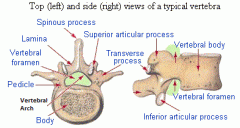
|
|
|
ATLAS label anterior tubercle, fovea antis, articular facets, posterior tubercle, transverse foramen |

|
|
|
on the atlas what does the superior articular facet articulate with? |
occipital bone, allows you to nod(atlanto-occipital joint) |
|
|
does the atlas have a spinous process? |
nO! it has a posterior tubercle instead |
|
|
what are the conditions lordosis and kyphosis associated with? |
lordosis: secondary curvature: wasyback appearnace kyposis: hunchback appearance (primary curvature) |
|
|
what is a hangman's fracture? |
when the pedicle breaks |
|
|
what vertebrae has a dens? |
axis |
|
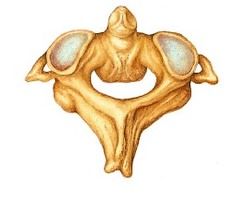
what vertebrae is this? |
axis |
|
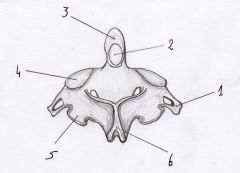
label this bone what level is this at? |
1) transverse foramen 2) body 3) dens 4) superior articular surface 5) lamina 6) spinous process C2 |
|
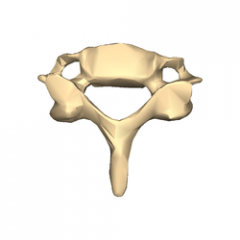
What vertebrae is this? how can you tell? |
-triangle vertebral foramen -small and broad vertebral body -short transverse process -short bifid (split) hw, horizontal spinous process -transverse foramens |
|
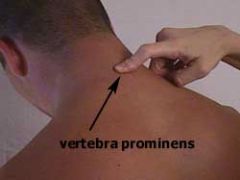
what level is the vertebral prominens? |
C7 long spinous process, palpable
|
|
|
what does the cervical rib that grows out the vertebral prominens (C7) compress? |
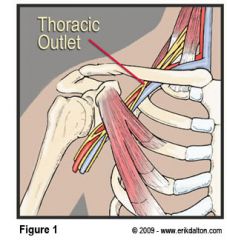
subclavian artery, subclavian vein, brachial plexus
-thoracic outlet syndrome (weak, numb and tingly in upper limb) |
|
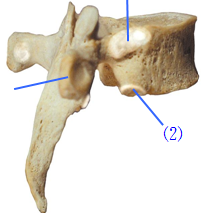
What vertbebrae is this? how can you tell? |

thoracic -medium and heart shaped vertebral body -circular vertebral foramen -long and strong transverse process -long and DOWNWARD facing spinous process |
|
|
what does the inferior and costal facet and the transverse costal facet articulate with? |
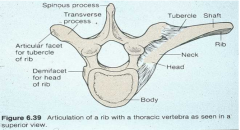
inferior and costal facet=head of ribs transverse costal facets=tubercle of rib |
|
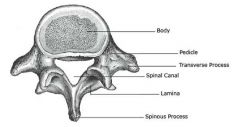
What vertebrae is this and how do you know? |
Lumbar large vertebral body long slender and horizontal transverse process short, thick and horizontal spinous process vertebral foramen is triangular |
|
|
why do the thoracic vertebrae have well marked transverse process? |
ribs attatch to them |
|
|
where does the spinal cord begin? |
continuation of medulla oblongata |
|
|
when does the spinal cord end? |
at conus medullaris T12-L3 |
|
|
where are the cervical and lumbosacral enlargements? |
cervical: C4-T1 Lumbosacral: L1-S3
|
|
|
what is the caudal equine? |
bundle of nerve roots running through lumbar cistern 'horse tail' |
|
|
what is the lumbar cistern? |
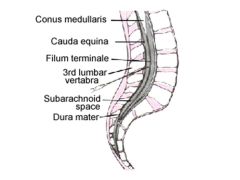
the caudal equine runs through it, with CSF a sub-arachnoid space enlargement |
|
|
what is the film terminale? |
inferior end of conus medullaris consists of pia mater includes: neural tissue, connective tissue, neurological tissue layers of arachnoid and dura mater penetrates dural sac and passes through sacral hiatus attaches to coccyx and dural sac |
|
|
There are anterior and posterior roots of spinal nerves what are the difference between the anterior and posterior roots? |
posterior: afferent skin fibres-SENSORY anterior: efferent from SkM-MOTOR |
|
|
where are the cell bodies for the anterior and posterior roots of the spinal nerves? |

ant: anterior horns of grey matter post: spinal ganglia |
|
|
what do the posterior and anterior roots of the spinal nerves innervate? |
post: skin and deep muscles of back ant: limbs and rest of trunk |
|
|
what are the 3 layers of the meningeal coverings of the spinal card? |

PIA MATER ARACHNOID MATER DURA MATER
protect the spinal cord |
|
|
what is the pia mater a continue as? |
filum terminale |
|
|
the spinal arachnoid mater lines the ____ ____ and encloses the __________ space. It is held against inner surface of dura by ____ Pressure. |
the spinal arachnoid mater lines the dural sac and encloses the sub-arachnoid space. It is held against inner surface of dura by CSF Pressure. |
|
|
what is the spinal dura mater coniunous with? |
cranial dura mater |
|
|
what anchors the spinal dural mater to the coccyx? |
filum terminale |
|
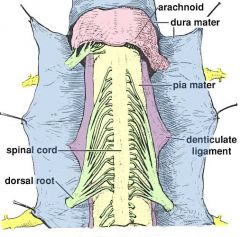
what are the denticulate ligaments? |
suspend spinal cord in dural sac extend midway between posterior and anterior nerve roots |
|
|
what is the extradural (epidural) space? |
wall of vertebral canal to dura matter contains: fat, internal vertebral venous plexus |
|
|
where is the sub-arachnoid space and what does it contain? |
arachnoid to pia mater
contents: CSF, arachnoid trabeculae, radicular, segmental, medullary and spinal arteries and veins |
|
|
where is a lumbar spinal puncture done? |
L3/L4, obtain CSF sample from sub-arachnoid space pt. lies forward on side with back flexed, spreads laminae and spinous processes |
|
|
what movements can the cervical spine do? |
flexion, extensiom, lateral flexion and roatation, extremely flexible IVDs and ZPJs relatively large |
|
|
what movements can the thoracic spine do? |
roation, IVDS extremely thin
|
|
|
What movements can the lumbar spine do? |
flexion, extension and lateral flexion high flexibility (especilally extension) large IVDs, interlocking articular processes prevent rotation |
|
|
what are the extrinsic muscles of the back? |
superficial: traps, lattissmus dorsi, rhomboids (attach and move upper limb)
intermediate: serratus post. sup. inf. (respiratory and proprioception ) innervated by ant. rami |
|
|
what are the intrinsic muscles of the back? |
superficial: spinotransversalis movement of spine intermediate: erector spinae movement of spine deep: transcersospinales stability and movement of spine innervated by posterior rami |
|
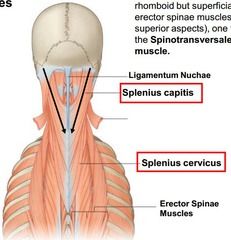
what are the two muscles that make up the spinotranversalis (superficial intrinsic back muscle)? |
splenius capitis (Spinous processes to occipital bone) spelnium cervicalis (spinous processes to transverse process C1-C3)
action: alone: laterally flex together: extend head and neck |
|
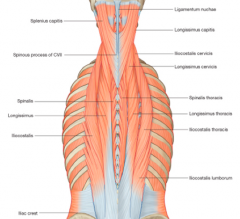
what are the 3 muscles that make up the erector spinae (intermediate intrinsic back muscle)? |
all arise from iliac crest, sacrum spinous process lateral: ilicostalis (to lower ribs and cervival t.p's) longissimus (toracic and cervical t.p's +mastoid) medial: spinalis (thoracic t.p's and cranium) action: bilaterally: extend vertebral column and head unilaterally: laterally flex vertebral column |
|
|
what are the three muscles that make up the transversospinales (deep intrinsic back muscle)? |
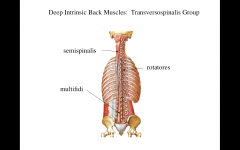
t.p's to superior s.p's semispinalis: 4-6 vertebrae multufundus: 2-3 vertebrae rotatores: 1-2 vertebrae action: proprioception, stabilisaiton, rotation and extension
|
|
|
what is the difference between a sprain and a strain? |
sprain: injury to the ligament (caused by excessive rotation or extension) strain: injury to the muscle itself (esp. lumbar erector spinae) often caused by heavy lifting |

